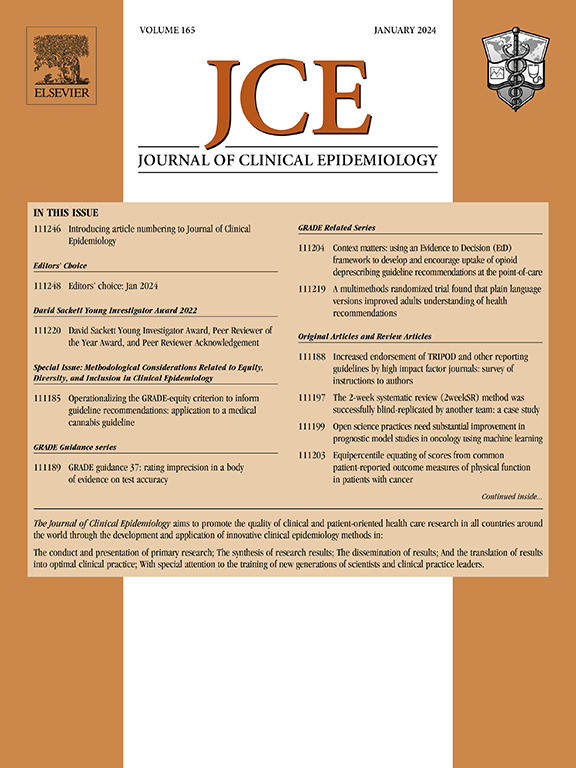Evaluation of Methods for Joinpoint Analysis of Time Series Using Simulated and Real-World Data
IF 5.2
2区 医学
Q1 HEALTH CARE SCIENCES & SERVICES
引用次数: 0
Abstract
Objectives
Joinpoint regression (JR) is implemented in time series analysis to identify trend changes without predefined shift points. This study compares the performance of the Joinpoint Regression Program (JRP) and R “segmented” package in detecting joinpoints using simulated and real-world data on pediatric mental health (MH)–related hospitalizations.
Study Design and Setting
Simulated datasets (n = 1000) were generated with varying residual autocorrelation, trend change magnitude, and joinpoint locations to evaluate the performance of both software (accuracy, specificity, coverage of the 95% confidence interval [95% CI] coverage, monthly percent change [MPC], coverage of the last segment). In addition, monthly proportions of pediatric MH-related hospitalizations (January 2016–December 2023) were analyzed to compare the number of joinpoints identified and the average monthly percent change (AMPC).
Results
In simulations without residual autocorrelation and no joinpoint, JRP exhibited a specificity of 92.7% compared to 97.9% for R. With an important trend change, the accuracy and 95% CI coverage were 59.0% and 81.7% using JRP and 69.4% and 76.8% using R. The coverage of the MPC of the last time segment varied from 93.0% to 97.9% using JRP and from 0% to 98.3% using R. When residual autocorrelation was introduced with a moderate trend change toward the end of the dataset, the accuracy and 95% CI coverage were 72.6% and 95.0% using JRP and 52.8% and 67.1% using R. The coverage of the MPC of the last time segment varied from 4.8% to 98.6% using JRP and from 0% to 96.9% with R. In the analysis of MH-related hospitalizations, among girls aged 6–11 years, JRP detected four joinpoints (AMPC: 0.11%), while R found 1 (AMPC: 0.05%). For boys aged 12–17 years, JRP identified four joinpoints vs three using R.
Conclusion
The choice of JR software should be guided by the characteristics of the dataset. The R “segmented” package may be more appropriate for datasets without residual autocorrelation, whereas JRP appears to provide more reliable estimates when analyzing autocorrelated health care data or data with no underlying trend changes.
Plain Language Summary
This study compares two methods for analyzing changes in trends over time. The two tools examined are the Joinpoint Regression Program (JRP) and the R “segmented” package. Using both simulated data and real-world hospital data, we assessed the performance of these tools. The simulated data included two scenarios: one without residual autocorrelation (simpler) and another with residual autocorrelation (where data points are related to previous ones, often seen in health care data). In the simpler scenario, the R package outperformed JRP by being more accurate in detecting changes and avoiding false detections. It also provided more precise estimates, with smaller uncertainty around the change points. However, when dealing with the more complex scenario involving residual autocorrelation, the JRP performed better, especially when changes occurred later in the timeline. However, early trend changes in the time series were challenging to detect for both JRP and R software. When analyzing real-world data on children's mental health hospitalizations, the JRP tended to identify more changes in trends than the R package. However, both softwares produced broadly similar results for the overall trends. The JRP is user-friendly and works well with data that include complex patterns like residual autocorrelation, but it does not account for seasonal effects and may detect more changes than are truly present. The R package, on the other hand, offers greater precision and flexibility for simpler data but requires more advanced programming skills and does not perform as well when handling data with residual autocorrelation. In summary, the choice between these tools should be driven by the type of data being analyzed: the R package is better for straightforward data, while the JRP is more suited for complex datasets such as those found in health care.
使用模拟和真实数据的时间序列连接点分析方法的评价。
目的:在时间序列分析中实现接合点回归(JR),以识别没有预定义移位点的趋势变化。本研究比较了连接点回归程序(JRP)和R“分段”包在使用儿童心理健康(MH)相关住院的模拟和现实世界数据检测连接点的性能。研究设计和设置:生成具有不同残差自相关、趋势变化幅度和连接点位置的模拟数据集(n=1000),以评估两种软件的性能(准确性、特异性、95%置信区间[95% ci]覆盖率的覆盖率、最后一段的月度百分比变化[MPC]覆盖率)。此外,分析了2016年1月至2023年12月儿童mh相关住院的每月比例,以比较确定的关节点数量和平均每月百分比变化(AMPC)。结果:在模拟没有残余自相关和连接点,JRP表现出92.7%到97.9%的特异性r和一个重要的趋势变化,准确性和95%可信区间使用JRP和覆盖率分别为59.0%和81.7%,69.4%和76.8%使用r .货币政策委员会的报道最后一次段不同使用JRP从93.0%到97.9%,从0%到98.3%使用r .剩余自相关介绍与温和的趋势变化时对数据集的结束,JRP的准确率和95%CI覆盖率分别为72.6%和95.0%,R的准确率和95%CI覆盖率分别为52.8%和67.1%。最后一个时间段的MPC覆盖率在JRP的4.8%到98.6%之间,R的覆盖率在0%到96.9%之间。在mh相关住院的分析中,6-11岁女孩中,JRP检测到4个接点(AMPC: 0.11%), R发现1个接点(AMPC: 0.05%)。对于12-17岁的男孩,JRP识别出了4个连接点,而r识别出了3个。结论:JR软件的选择应以数据集的特征为指导。R“分段”包可能更适合于没有残差自相关的数据集,而JRP在分析自相关的医疗保健数据或没有潜在趋势变化的数据时似乎提供了更可靠的估计。
本文章由计算机程序翻译,如有差异,请以英文原文为准。
求助全文
约1分钟内获得全文
求助全文
来源期刊

Journal of Clinical Epidemiology
医学-公共卫生、环境卫生与职业卫生
CiteScore
12.00
自引率
6.90%
发文量
320
审稿时长
44 days
期刊介绍:
The Journal of Clinical Epidemiology strives to enhance the quality of clinical and patient-oriented healthcare research by advancing and applying innovative methods in conducting, presenting, synthesizing, disseminating, and translating research results into optimal clinical practice. Special emphasis is placed on training new generations of scientists and clinical practice leaders.
 求助内容:
求助内容: 应助结果提醒方式:
应助结果提醒方式:


